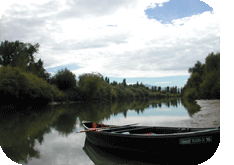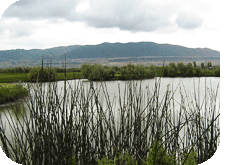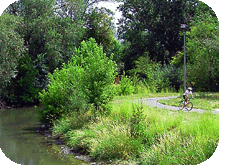
This mailer has been provided as an avenue of dispersing information related to landscape architecture in hopes of fostering greater understanding and collaboration between professions. Topics address issues that affect the built environment within which we live.
A synopsis of the concept as coined by Richard Louv
"When I see birches bend to left and right....I like to think some boys been swinging them", Robert Frost
My experiences as a child building huts and forts in neighborhood vacant lots overgrown with shoulder high weeds, exploring nearby orchards, hiking through the Wasatch Mountains as a young Boy Scout, climbing the family cherry tree and cultivating the family garden alongside my grandfather are all treasured memories of my early intimate interactions with natural settings. Despite broken bones, cuts, scratches and a few close encounters with wildlife, I recall many occasions when nature's magic lulled me into trances of serene and peaceful thought. These events had a significant impact on my choices later in life, eventually guiding me to an occupation as a landscape architect. Natural settings continue to have this effect on me providing an escape from the busy tasks of life. I often find myself lost in thought while fly fishing in California's Sierra Mountains or while cultivating my version of the "family vegetable garden." As I look at my own young family, I can not help but notice the glaring contrast between my childhood and the gross lack of exposure my children have to the same natural environments I took for granted. Richard Louv, the author of Last Child in the Woods,suggests that this scenario is not an isolated observation but that it is a potentially negative national trend demanding attention. Though "nature-deficit disorder" is not a clinical diagnosis, the statement does bring to light the seriousness of the condition that many people see this to be. Below are a few of the many topics covered in Louv's book including our society's decreasing exposure to nature, the need for exposure to nature and efforts that can be made to improve exposure to nature.
 Decreasing Exposure to Nature - A generation of children raised with difficult to resist temptations created by computers and electronics are showing increasingly alarming trends towards a lack of knowledge and understanding of the natural environments around them. Louv quotes a fourth grade child in his book who disturbingly, but somehow not surprisingly, prefers to play inside because "that's where all the electrical outlets are." This statement reinforces the results of studies conducted by the Kaiser Family Foundation reporting that nearly one-third of children six months old to six years old live in homes where the television is on for the majority of the day and that an average of 6.5 hours a day (45 hours/week) are spent using electronics by children between the ages of eight and eighteen. In fact, one astonishing study tracked the movement of three year old's throughout the week and discovered that these children spent less than 20 minutes a day in active movement. Time spent in front of electronics, busy parents, and overly structured schedules may be a few of the many causes resulting in a nationwide reduction of time spent in natural environments. Evidence to support this is clear in recorded attendance at national and state parks over the past two decades where, despite increasing populations, 20-50% declines in visitors have been experienced. Other activities such as hunting and bird watching have also experienced similar declines. Decreasing exposure to nature is commonly referred to as "nature-deficit-disorder".
Decreasing Exposure to Nature - A generation of children raised with difficult to resist temptations created by computers and electronics are showing increasingly alarming trends towards a lack of knowledge and understanding of the natural environments around them. Louv quotes a fourth grade child in his book who disturbingly, but somehow not surprisingly, prefers to play inside because "that's where all the electrical outlets are." This statement reinforces the results of studies conducted by the Kaiser Family Foundation reporting that nearly one-third of children six months old to six years old live in homes where the television is on for the majority of the day and that an average of 6.5 hours a day (45 hours/week) are spent using electronics by children between the ages of eight and eighteen. In fact, one astonishing study tracked the movement of three year old's throughout the week and discovered that these children spent less than 20 minutes a day in active movement. Time spent in front of electronics, busy parents, and overly structured schedules may be a few of the many causes resulting in a nationwide reduction of time spent in natural environments. Evidence to support this is clear in recorded attendance at national and state parks over the past two decades where, despite increasing populations, 20-50% declines in visitors have been experienced. Other activities such as hunting and bird watching have also experienced similar declines. Decreasing exposure to nature is commonly referred to as "nature-deficit-disorder".
 Exposure to Nature is Necessary- "Children need nature for the healthy development of their senses, and, therefore for learning and creativity. This need is revealed in two ways: by an examination of what happens to the senses of the young when they lose connection with nature, and by witnessing the sensory magic that occurs when young people - even those beyond childhood - are exposed to even the smallest direct experience of a natural setting." Louv
Exposure to Nature is Necessary- "Children need nature for the healthy development of their senses, and, therefore for learning and creativity. This need is revealed in two ways: by an examination of what happens to the senses of the young when they lose connection with nature, and by witnessing the sensory magic that occurs when young people - even those beyond childhood - are exposed to even the smallest direct experience of a natural setting." Louv
The significance of access to nature is a relatively young research topic, but yet, is fairly well documented. Available studies consistently show that holistic child development is closely tied to unstructured play, rich in imaginative and exploratory activities. Nature rich play spaces are educational spaces that foster stronger friendships, reduce stress, improve focus and attention, improve cognitive function, provide opportunities for unlimited interpretation of the environment, and allow children to use all of their senses to discover and rediscover. Natural settings enhance creativity and inventiveness through innate abundant variability. Designers attempt to mimic nature's variability by incorporating non-stationary features into traditional public play spaces. This often fails due primarily to litigation, theft and safety concerns. In reality, "nature, which excites all the senses, remains the richest source of loose parts (Variables)." In addition to the myriad psychological benefits associated with nature, the physical body also benefits through improved stamina, physical fitness and health. A recent study compared children who played in natural unstructured play areas with those who recreated in traditional playgrounds. The first group exhibited better physical control over motor functions, such as agility and balance, than their counterparts who played for the same amount of time.
 Efforts to Increase Exposure to Nature - In his book, Louv offers many potential ways to re-emphasize the importance of nature, ranging from planting a garden to creation of "play reservations" to reformation of laws related to recreation related litigation. Each of these great ideas will vary in effectiveness at addressing and attempting to rectify core reasons for the lack of exposure to nature in society; however, there is no immediate simple solution to removing all the barriers that keep children and adults from interacting with these spaces. Each day children are told they cannot climb a tree because it will harm the tree or is too dangerous, they cannot pick a flower or leaf because it will damage the plant, or that they cannot play with a stick because someone will get hurt. These flawed barriers to unrestricted play must be the first on the list for deconstruction.
Efforts to Increase Exposure to Nature - In his book, Louv offers many potential ways to re-emphasize the importance of nature, ranging from planting a garden to creation of "play reservations" to reformation of laws related to recreation related litigation. Each of these great ideas will vary in effectiveness at addressing and attempting to rectify core reasons for the lack of exposure to nature in society; however, there is no immediate simple solution to removing all the barriers that keep children and adults from interacting with these spaces. Each day children are told they cannot climb a tree because it will harm the tree or is too dangerous, they cannot pick a flower or leaf because it will damage the plant, or that they cannot play with a stick because someone will get hurt. These flawed barriers to unrestricted play must be the first on the list for deconstruction.
Most importantly however, the responsibility for exposing our children's generation to nature lies with those of us who have built tree houses, climbed boulders larger than our homes, explored river bottoms and experienced that world first hand. The youth of today need a companion who will share with them, discover with them, and enjoy with them the excitement and wonder of the world that surrounds them.
Prior Issues of Interest
- Nature Series: The Healing Power of Nature
- Nature Series: Infusing Nature into Play
- The Parks and Rec Budget Reduction Trend
- Artificial Landscape Water Cycles
- Dog Park Basics
- Playground Safety: What's the Big Deal?
The next time you need a Landscape Architect on your project, consider O'Dell Engineering's Landscape Architecture Department.
Services include:
- Park and Playground Design
- Recreational Facility Design
- Site Planning
- Streetscape Design
- Urban Design
- Commercial Design
- Model / Production Homes
- 3-D Visualizations
- Graphic Design
- Arboriculture Consulting
- Playground Inspection
References:
1-Louv, Richard. Last Child in the Woods: Saving Our Children from Nature-Deficit Disorder. Algonquin Books of Chapel Hill. Chapel Hill, North Carolina. 2008.

Author: Chad Kennedy, Landscape Architect
This informational article provided by O'Dell Engineering - 1165 Scenic Drive, Suite A, Modesto CA 95350